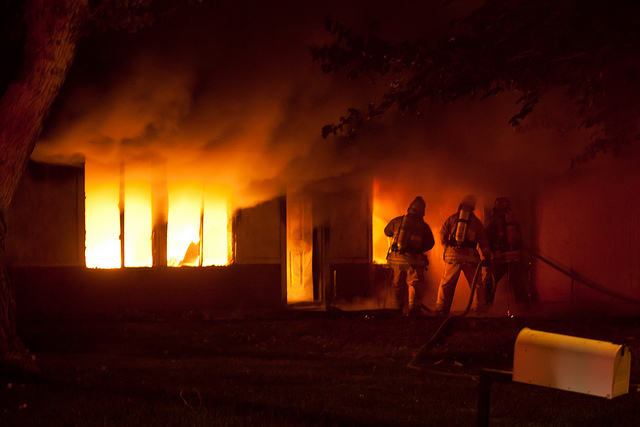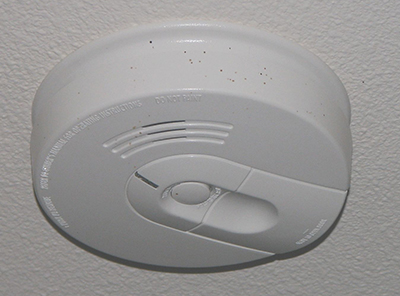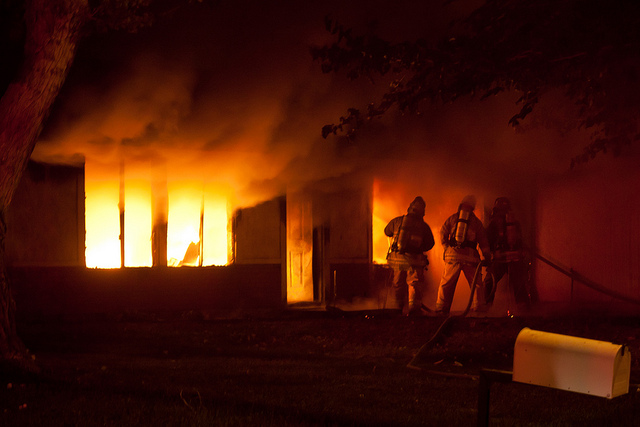Restoring Kitchen Fire Damaged Furniture
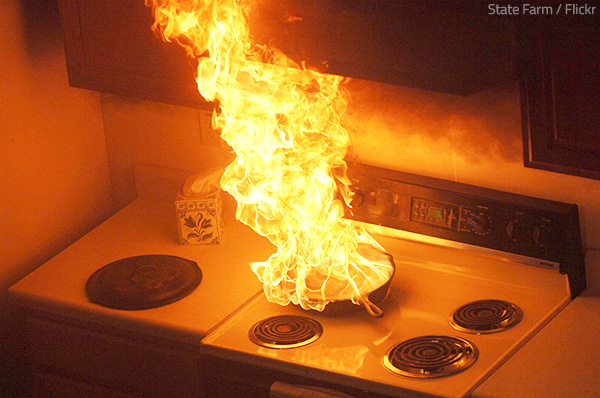
One third of home fires occur in the kitchen.
In the aftermath of a house fire, you need to take quick and efficient measures to restore the good condition of your property and get your life back on track as soon as possible after the disaster. Even if the fire was small and contained to one room, smoke and sootSoot is fine black particles composed of carbon and other ma... More would have likely spread throughout the home, affecting walls, carpets, furniture, appliances, and other household items. Furniture is especially vulnerable to fire damage – it is usually made of wood and upholstery materials, both of which are very flammable and quite porousPorous describes a material that contains small openings or ... More (so they easily absorb sootSoot is fine black particles composed of carbon and other ma... More and smoke odorAn odor is a smell, often detectable by the human nose, whic... More). Time is, therefore, of the essence for saving your furniture – sootSoot is fine black particles composed of carbon and other ma... More and smoke particles will begin to embed into the wood and upholstery within minutes, so you need to clean the pieces immediately after the disaster.
Depending on the extent of the damage, it may or may not be possible to salvage your furniture. If it’s not severely burnt, however, but only covered in sootSoot is fine black particles composed of carbon and other ma... More and smelling like smoke, you have every chance of success – as long as you know what to do. Here are the right steps to take when cleaning and restoring fire damaged furniture (and kitchen furniture, in particular, as most house fires happen in the kitchen):
Before You Start Cleaning Furniture after a Fire
Cleaning fire damage is not only time-consuming and difficult, but also quite risky – you need to take some important precautionary measures and prepare well before you can initiate the restorationRestoration is the process of returning a property to its pr... More process:
- Do not re-enter your home until permitted by local building officials or the fire department;
- Make sure you wear long pants, a long-sleeved shirt, work gloves, safety goggles, a hard hat, and boots with rubber soles when you go back into the house;
- Open doors and windows to increase ventilationVentilation is the process of exchanging or circulating air ... More and get rid of residual smoke (if some of the rooms of your home were not affected by the fire, keep their doors closed to prevent sootSoot is fine black particles composed of carbon and other ma... More and smoke from spreading to those areas);

Make sure the fire has been completely extinguished before re-entering your home.
- Take household items and personal belongings that have not been damaged by the fire to a safe and clean place;
- Discard badly damaged items that cannot be salvaged;
- Dry wet household materials and items (drenched by the water used to put out the fire) before you start cleaning smoke damage – use fans and dehumidifiers to speed up the process;
- Remove the hardware from your furniture – wipe all the metal parts with a clean rag dipped in kerosene, let them air dry, and apply a thin coat of oil all over the surfaces to keep the metal from corroding;
- If possible, work outdoors when cleaning smoke damaged furniture. If not, protect the floor and the surrounding items in your work area with plastic drop cloths or old sheets and keep the windows wide open.
Good to remember: Most solvents and cleaning materials are highly flammable, so make sure there is no flame or spark anywhere in the area.
How to Clean Smoke Damaged Furniture
Smoke damage cleanup is a laborious task that requires a lot of patience and hard work:
Step 1. How to Clean Soot off Furniture
So, your furniture survived the fire (it isn’t scorched!), but it has suffered smoke damage and is covered in sootSoot is fine black particles composed of carbon and other ma... More. Smoke consists of gases, microscopic droplets of wood tars, and tiny particles of carbon (ash, sootSoot is fine black particles composed of carbon and other ma... More, etc.) that can easily penetrate any porousPorous describes a material that contains small openings or ... More materials (like wood and upholstery) and cause severe damage. It leaves an acidic film on all surfaces it comes in contact with and is very difficult to remove (in fact, touching furniture that has been affected by smoke exacerbates the corrosion of the pieces, so professionals wear nitrile gloves to prevent this from happening).
Therefore, your first and foremost task when cleaning furniture after a fire is to remove the sootSoot is fine black particles composed of carbon and other ma... More:
-
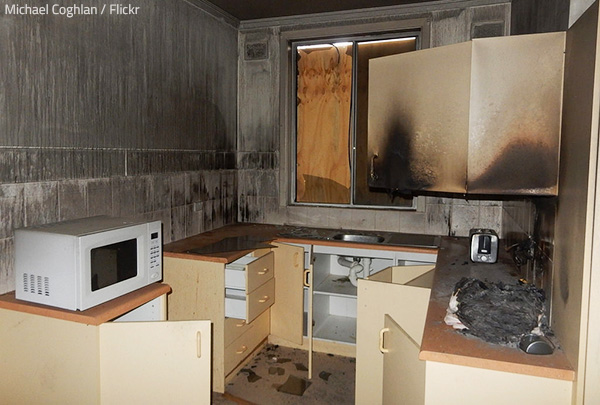
SootSoot is fine black particles composed of carbon and other ma... More and smoke damage cleanup is a time-consuming and laborious process.
Vacuum all surfaces of the furniture with a hard nozzle crevice tool – hold the attachment slightly above the surface to force loose sootSoot is fine black particles composed of carbon and other ma... More particles and dust into the vacuum instead of pushing them into the furniture materials. Do not use the brush attachment as it may help grind the smoke particles deeper into the wood or upholstery;
- Wipe all wood surfaces with a dry chemical spongeA sponge is a porous material used to absorb liquids or clea... More to remove sootSoot is fine black particles composed of carbon and other ma... More embedded in the grain. Be careful not to scrub too hard;
- Lightly wipe all wood surfaces with a cotton cloth dipped in a mixture of 1/4 cup oil soap (or wood cleaner) and 1 gallon warm water;
- If necessary, use 0000 grade steel wool to remove tough sootSoot is fine black particles composed of carbon and other ma... More residueResidue is any leftover material, such as soot, dust, or che... More (make sure you work in the direction of the wood grain);
- Wipe the furniture with a damp cloth and let it air dry.
Good to remember: Unfinished wood (such as the insides of drawers and cabinets) has no protective sealer or varnish and is much more vulnerable to smoke or sootSoot is fine black particles composed of carbon and other ma... More damage than finished wood – it absorbs a lot of sootSoot is fine black particles composed of carbon and other ma... More and smoke odorAn odor is a smell, often detectable by the human nose, whic... More which makes the unfinished surfaces very difficult to clean. When cleaning unfinished wood, you’re advised to remove loose sootSoot is fine black particles composed of carbon and other ma... More with a dry spongeA sponge is a porous material used to absorb liquids or clea... More first, then wipe the area with a cloth dipped in an appropriate cleaning solutionA solution is a homogeneous mixture of two or more substance... More (use a mild detergent or a degreaser diluted to label instructions), rinse with clean water, and lightly sand the surfaces with fine grit sandpaper until all sootSoot is fine black particles composed of carbon and other ma... More stains are gone.
Step 2. How to Clean Smoke Damaged Wood Furniture
Once the sootSoot is fine black particles composed of carbon and other ma... More has been removed, smoke damaged wood furniture needs to be treated with specialized cleansing agents that will remove discoloration and stains. Then, the finish has to be restored with a wood polish or conditioner and carefully buffed with a soft cloth:
-
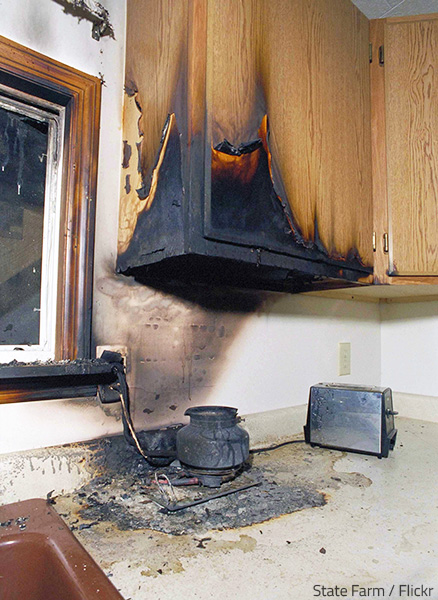
Your first step when cleaning smoke damaged wood furniture is to sand away charred areas and sootSoot is fine black particles composed of carbon and other ma... More stains.
Sand away charred areas, burn stains, and sootSoot is fine black particles composed of carbon and other ma... More stains with fine grit sandpaper;
- Wipe the furniture with a tack cloth to clean off any dust from the sanding;
- Apply a cream furniture restorationRestoration is the process of returning a property to its pr... More polish over all wood surfaces. Let it sit for 5 to 10 minutes;
- Use 0000 steel wool to work the cream polish into the wood (make sure you follow the grain of the wood);
- Wipe excess polish away with terrycloth towel;
- Buff the surface with a dry cloth (it is also a good idea to rub lemon oil polish into the wood, as it will not only restore its luster, but will also help neutralize the smoke odorAn odor is a smell, often detectable by the human nose, whic... More).
If your kitchen cabinets, kitchen table, kitchen chairs, or other wood furniture has been severely damaged by the fire, you may need to have the piece(s) fully refinished (for best results, consider using professional wood refinishing services).
Step 3. How to Clean Smoke Damaged Upholstery
In most cases, fire damaged upholstery has to be replaced after the accident. If your kitchen couch or kitchen chair upholstery has sustained only light smoke damage, however, you may be able to save it and restore it to its original good condition:
How to clean smoke damaged leather furniture:
- Vacuum the sootSoot is fine black particles composed of carbon and other ma... More off the furniture holding the flat nozzle attachment just above the leather surface;
- Apply quality leather soap (or appropriate leather conditioner) to a clean, soft cloth and gently wipe the leather surface with it;
- Mix equal parts white vinegar and water in a spray bottle and spray the leather. Wipe the furniture with a clean rag dampened in clear water (be careful not to saturate the leather) and let it air dry.
Good to know: Steam cleaning can salvage smoke damaged leather furniture, so make sure you talk with a professional before attempting to clean your fire damaged kitchen upholstery by yourself. After all, leather is a delicate and luxurious material that requires careful treatment (you have to be careful not to let it get too wet or scratch the fine surface while trying to clean your smoke damaged leather furniture) and specialized cleaning equipment, so professional cleaning is your best bet.
How to clean smoke damaged fabric furniture:
- Pull off removable fabric coverings and machine-wash them in cold water (add 1 cup of white vinegar to the water). If possible, hang the covers outside to dry in sunshine and fresh air;
- Vacuum fabric upholstery that cannot be removed from the furniture to remove loose sootSoot is fine black particles composed of carbon and other ma... More. Sprinkle baking soda over the entire fabric surface, let it sit for 24 hours, and vacuum. Repeat, if necessary.
Good to know: Fibers in fabric upholstery “trap” the smoke odorAn odor is a smell, often detectable by the human nose, whic... More and can slowly release smoke and sootSoot is fine black particles composed of carbon and other ma... More particles throughout your home, contaminating the air. So, even if your fabric kitchen couch (or fabric kitchen chairs) looks fine, make sure you clean the upholstery thoroughly to get rid of the smoke particles.
Step 4. How to Remove Smoke Odor from Furniture
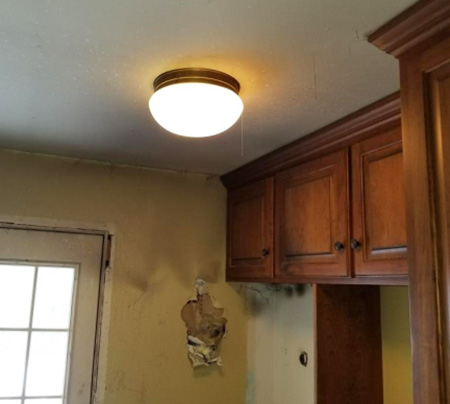
Kitchen cabinets before furniture restorationRestoration is the process of returning a property to its pr... More
All the specialized wood cleaners, cream furniture restoration polishes, lemon oil polishes, etc. used for restoring fire damaged wood furniture help remove smoke odorAn odor is a smell, often detectable by the human nose, whic... More from the wood, while baking soda and vinegar help get the smell off the upholstery. Yet, this may not be enough to completely remove the smoke odorAn odor is a smell, often detectable by the human nose, whic... More from your fire damaged furniture – the professionals use a strong oxidizing agentAn oxidizing agent is a chemical that causes another substan... More, such as ozone, to dissipate the smell.
An ozone generator is set up in the room where the affected furniture is and runs for several hours (depending on the degree of damage and the type of smoke chemicals that are present). During this time, the ozone (a gas that contains an extra oxygenOxygen is a chemical element essential for combustion and li... More atom) attaches itself to the odor-causing molecules and restructures them into molecules that don’t create odorAn odor is a smell, often detectable by the human nose, whic... More. There shouldn’t be any hint of smoke left on your furniture when the so called oxidationOxidation is a chemical reaction in which a substance combin... More process is completed.
Smoke odorAn odor is a smell, often detectable by the human nose, whic... More removal is part of the professional furniture cleaning and restorationRestoration is the process of returning a property to its pr... More process.
Use Professional Furniture Restoration Services
Now that you know how to clean furniture after a fire, you can decide if you’re up to the task or if it is too much for you to handle by yourself. If you’re not sure you can achieve good results or if your kitchen furniture is too badly damaged, do not hesitate to call a furniture restorationRestoration is the process of returning a property to its pr... More professional – the experts offer disaster furniture restoration services specifically for fire and smoke damaged furniture. They have the advanced equipment and specialized cleaning materials, as well as the extensive training and rich experience, required to do the job in the safest and most efficient way possible. At Furniture Medic by MasterCare Experts we offer:
-

Kitchen cabinets after professional fire damaged furniture restorationRestoration is the process of returning a property to its pr... More
sootSoot is fine black particles composed of carbon and other ma... More and smoke damage cleanup;
- removal and rebuilding of charred or burned furniture pieces;
- refinishing fire damaged furniture;
- smoke damage repairRepair is the act of fixing or restoring damaged property, m... More to fully restore wood furniture, cabinets, doors, and hardwood floors affected by fire to their original condition;
- smoke odorAn odor is a smell, often detectable by the human nose, whic... More removal.
Contact a Furniture Restoration professional today to have your furniture professionally cleaned after a fire. You will save a lot of money in replacements and will ensure the original look and feel of your wood pieces for years to come.










